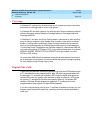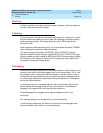
MERLIN LEGEND Communications System Release 6.1
Network Reference
555-661-150
Issue 1
August 1998
Feature Interactions
Page 3-13Forward and Follow Me
3
Forward and Follow Me 3
The use of Forward and Follow Me in networked systems is as follows:
■ For Release 6.0 and later systems, Follow Me is not supported across the
private network.
■ For Release 6.1 and later systems, Call Forwarding is used to forward calls
directly to a non-local extension; you do not have to enable Remote Call
Forwarding. When programming call forwarding to a non-local extension,
add # at the end of a number.
■ For Release 6.0 systems, Remote Call Forwarding can be used in
combination with Caller ID on a loop-start PSTN line connected to an 800
LS-ID line/trunk module. The LS-ID Delay option must be programmed to
On for each line connected to the 800 LS-ID module. To pass Caller ID
information across the private network when a call is transferred, set the
Remote Call Forwarding Delay to one ring. Transfer of the call must be
completed before the call is forwarded.
The user at the extension that first receives the Caller ID call from the PSTN turns
Remote Call Forwarding on and specifies forwarding across the private network,
over PRI tandem trunks only, to a non-local extension with an MLX display
telephone.
Redirected transfer calls do not forward across the network.
Group Calling 3
Private networked trunks cannot be programmed to ring into calling groups,
because tandem trunks are dial-in facilities.
When calling group extensions are included in the non-local dial plan, calls to non-
local calling groups are made just as calls to other non-local dial plan extensions
are, using the calling groups’ extensions. Calls can be transferred to non-local
calling groups. If the transfer is completed while listening to a Delay
Announcement message, the announcement will not play again.
For Release 6.0, all members of a calling group must be connected to the same
local system.
In Release 6.1 and later, a calling group may have a
single
non-local member that
is defined under the Uniform Dial Plan as existing on another MERLIN LEGEND
Communications System connected by a tandem trunk. A calling group can have
a single non-local member or several local extensions. The same calling group
cannot
have both local members and a non-local member.
In Release 6.1 and later systems, a calling group containing a single non-local
member can be used for most of the same purposes as a calling group containing
only local extensions. This includes:


















